
Anemia is a genus of ferns. It is the only genus in the family Anemiaceae in the Pteridophyte Phylogeny Group classification of 2016. Alternatively, the genus may be placed as the only genus in the subfamily Anemioideae of a more broadly defined family Schizaeaceae, the family placement used in Plants of the World Online as of November 2019. Its species are sometimes called flowering ferns, but this term is more commonly applied to ferns of the genus Osmunda. Fronds are dimorphic; in fertile fronds, the two lowermost pinnae are highly modified to bear the sporangia.

The Athyriaceae are a family of terrestrial ferns in the order Polypodiales. In the Pteridophyte Phylogeny Group classification of 2016 (PPG I), the family is placed in the suborder Aspleniineae, and includes two genera. Alternatively, it may be treated as the subfamily Athyrioideae of a very broadly defined family Aspleniaceae. The family has with a cosmopolitan distribution.

Plagiogyria is a genus of ferns, the only genus in family Plagiogyriaceae in the Pteridophyte Phylogeny Group classification of 2016. Alternatively, the family may be treated as the subfamily Plagiogyrioideae of a very broadly defined family Cyatheaceae, the placement used for the genus in Plants of the World Online as of November 2019.
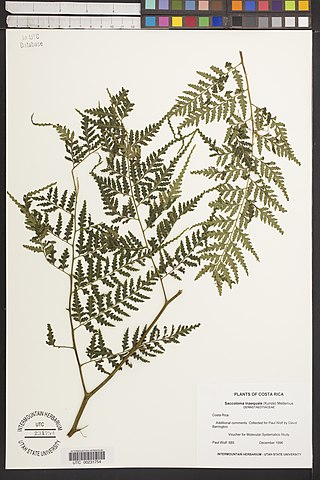
Saccoloma is a fern genus in family Saccolomataceae. It is the only genus in the family in the Pteridophyte Phylogeny Group classification of 2016, but further investigation is needed. It is pantropical and its species are found in wet, shaded forest areas. Saccoloma species are characterized by an omega-shaped (Ω) vascular bundle in the cross-sections of their petioles. The common name soralpouch fern is used for Saccoloma.

The Lomariopsidaceae is a family of ferns with a largely tropical distribution. In the Pteridophyte Phylogeny Group classification of 2016 (PPG I), the family is placed in the suborder Polypodiineae of the order Polypodiales. Alternatively, it may be treated as the subfamily Lomariopsidoideae of a very broadly defined family Polypodiaceae sensu lato.
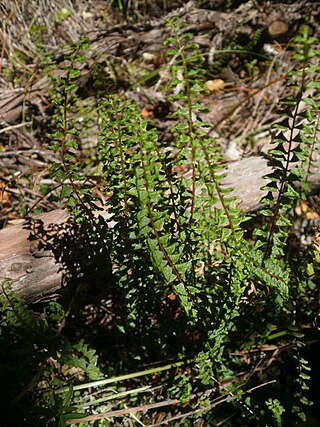
Lindsaeaceae is a pantropical family of ferns in the order Polypodiales. It contains six or seven genera with about 220 known species, some of which also extend into the more temperate regions of eastern Asia, New Zealand, and South America.

Cystopteridaceae is a family of ferns in the order Polypodiales. In the Pteridophyte Phylogeny Group classification of 2016 (PPG I), the family is placed in the suborder Aspleniineae of the order Polypodiales, and includes three genera. Alternatively, it may be treated as the subfamily Cystopteridoideae of a very broadly defined family Aspleniaceae.

Tectariaceae is a family of leptosporangiate ferns in the order Polypodiales. In the Pteridophyte Phylogeny Group classification of 2016 (PPG I), the family is placed in the suborder Polypodiineae. Alternatively, it may be treated as the subfamily Tectarioideae of a very broadly defined family Polypodiaceae sensu lato. The family comprises seven genera, of which Tectaria is by far the largest.

Lindsaea, common name necklace fern, is a genus of around 180 species of fern, 15 of which reach Australia. The name is in honour of surgeon John Lindsay of Jamaica. The genus is sometimes spelt Lindsaya.

Metaxya is a neotropical genus of ferns in the order Cyatheales. It is the only genus in the family Metaxyaceae in the Pteridophyte Phylogeny Group classification of 2016. Alternatively, the genus may be placed in the subfamily Metaxyoideae of a more broadly defined family Cyatheaceae, the family placement used in Plants of the World Online as of November 2019.

Polyphlebium is a fern genus in the family Hymenophyllaceae. The genus is accepted in the Pteridophyte Phylogeny Group classification of 2016 but not by some other sources.

Vandenboschia is a fern genus in the family Hymenophyllaceae. The genus is accepted in the Pteridophyte Phylogeny Group classification of 2016 but not by some other sources.
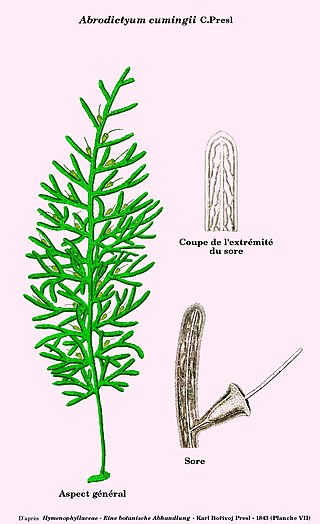
Abrodictyum is a fern genus in the family Hymenophyllaceae. The genus is accepted in the Pteridophyte Phylogeny Group classification of 2016 but not by some other sources, which sink it into a broadly defined Trichomanes.

Odontosoria is a genus of ferns in the family Lindsaeaceae.
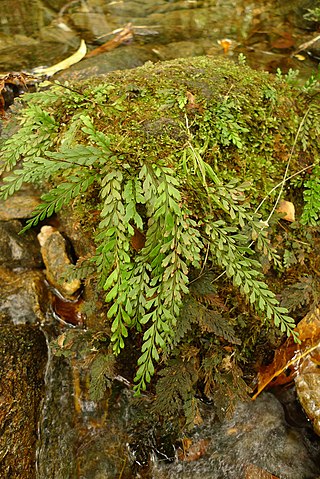
Austrogramme is a genus of ferns in the subfamily Pteridoideae of the family Pteridaceae.
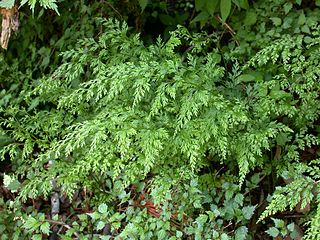
Onychium is a genus of ferns in the subfamily Pteridoideae of the family Pteridaceae.

Pterozonium is a genus of ferns in the subfamily Pteridoideae of the family Pteridaceae. Species are mainly found in north-western South America, as well as Costa Rica.
Syngramma is a genus of ferns in the subfamily Pteridoideae of the family Pteridaceae. Species are native to south-east tropical Asia and the Pacific.
Polytaenium is a genus of ferns in the subfamily Vittarioideae of the family Pteridaceae. Species are native to Mexico and Southern America.
Vaginularia is a genus of ferns in the subfamily Vittarioideae of the family Pteridaceae in the Pteridophyte Phylogeny Group classification of 2016. Other sources sink the genus into Monogramma, a genus not recognized in PPG I.
















